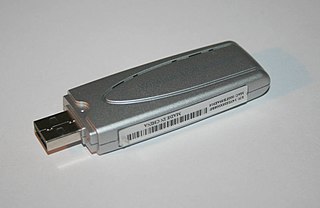IEEE 802.15 is a working group of the Institute of Electrical and Electronics Engineers (IEEE) IEEE 802 standards committee which specifies Wireless Specialty Networks (WSN) standards. The working group was formerly known as Working Group for Wireless Personal Area Networks.

A wireless LAN (WLAN) is a wireless computer network that links two or more devices using wireless communication to form a local area network (LAN) within a limited area such as a home, school, computer laboratory, campus, or office building. This gives users the ability to move around within the area and remain connected to the network. Through a gateway, a WLAN can also provide a connection to the wider Internet.

A wireless network is a computer network that uses wireless data connections between network nodes. Wireless networking allows homes, telecommunications networks and business installations to avoid the costly process of introducing cables into a building, or as a connection between various equipment locations. Admin telecommunications networks are generally implemented and administered using radio communication. This implementation takes place at the physical level (layer) of the OSI model network structure.
Zigbee is an IEEE 802.15.4-based specification for a suite of high-level communication protocols used to create personal area networks with small, low-power digital radios, such as for home automation, medical device data collection, and other low-power low-bandwidth needs, designed for small scale projects which need wireless connection. Hence, Zigbee is a low-power, low data rate, and close proximity wireless ad hoc network.

A wireless mesh network (WMN) is a communications network made up of radio nodes organized in a mesh topology. It can also be a form of wireless ad hoc network.

In IEEE 802.11 wireless local area networking standards, a service set is a group of wireless network devices which share a service set identifier (SSID)—typically the natural language label that users see as a network name. A service set forms a logical network of nodes operating with shared link-layer networking parameters; they form one logical network segment.
IEEE 802.11i-2004, or 802.11i for short, is an amendment to the original IEEE 802.11, implemented as Wi-Fi Protected Access II (WPA2). The draft standard was ratified on 24 June 2004. This standard specifies security mechanisms for wireless networks, replacing the short Authentication and privacy clause of the original standard with a detailed Security clause. In the process, the amendment deprecated broken Wired Equivalent Privacy (WEP), while it was later incorporated into the published IEEE 802.11-2007 standard.

The Optimized Link State Routing Protocol (OLSR) is an IP routing protocol optimized for mobile ad hoc networks, which can also be used on other wireless ad hoc networks. OLSR is a proactive link-state routing protocol, which uses hello and topology control (TC) messages to discover and then disseminate link state information throughout the mobile ad hoc network. Individual nodes use this topology information to compute next hop destinations for all nodes in the network using shortest hop forwarding paths.
Ad hoc On-Demand Distance Vector (AODV) Routing is a routing protocol for mobile ad hoc networks (MANETs) and other wireless ad hoc networks. It was jointly developed by Charles Perkins and Elizabeth Royer and was first published in the ACM 2nd IEEE Workshop on Mobile Computing Systems and Applications in February 1999.
IEEE 802.11r-2008 or fast BSS transition (FT), is an amendment to the IEEE 802.11 standard to permit continuous connectivity aboard wireless devices in motion, with fast and secure client transitions from one Basic Service Set to another performed in a nearly seamless manner. It was published on July 15, 2008. IEEE 802.11r-2008 was rolled up into 802.11-2012. The terms handoff and roaming are often used, although 802.11 transition is not a true handoff/roaming process in the cellular sense, where the process is coordinated by the base station and is generally uninterrupted.

A wireless network interface controller (WNIC) is a network interface controller which connects to a wireless network, such as Wi-Fi, Bluetooth, or LTE (4G) or 5G rather than a wired network, such as an Ethernet network. A WNIC, just like other NICs, works on the layers 1 and 2 of the OSI model and uses an antenna to communicate via radio waves.
Extensible Authentication Protocol (EAP) is an authentication framework frequently used in network and internet connections. It is defined in RFC 3748, which made RFC 2284 obsolete, and is updated by RFC 5247. EAP is an authentication framework for providing the transport and usage of material and parameters generated by EAP methods. There are many methods defined by RFCs, and a number of vendor-specific methods and new proposals exist. EAP is not a wire protocol; instead it only defines the information from the interface and the formats. Each protocol that uses EAP defines a way to encapsulate by the user EAP messages within that protocol's messages.
The IEEE 802.21 refers to Media Independent Handoff (MIH) and is an IEEE standard published in 2008. The standard supports algorithms enabling seamless handover between wired and wireless networks of the same type as well as handover between different wired and wireless network types also called Media independent handover (MIH) or vertical handover. The vertical handover was first introduced by Mark Stemn and Randy Katz at U C Berkeley. The standard provides information to allow handing over to and from wired 802.3 networks to wireless 802.11, 802.15, 802.16, 3GPP and 3GPP2 networks through different handover mechanisms.

Wireless security is the prevention of unauthorized access or damage to computers or data using wireless networks, which include Wi-Fi networks. The term may also refer to the protection of the wireless network itself from adversaries seeking to damage the confidentiality, integrity, or availability of the network. The most common type is Wi-Fi security, which includes Wired Equivalent Privacy (WEP) and Wi-Fi Protected Access (WPA). WEP is an old IEEE 802.11 standard from 1997. It is a notoriously weak security standard: the password it uses can often be cracked in a few minutes with a basic laptop computer and widely available software tools. WEP was superseded in 2003 by WPA, a quick alternative at the time to improve security over WEP. The current standard is WPA2; some hardware cannot support WPA2 without firmware upgrade or replacement. WPA2 uses an encryption device that encrypts the network with a 256-bit key; the longer key length improves security over WEP. Enterprises often enforce security using a certificate-based system to authenticate the connecting device, following the standard 802.11X.
IEEE 802.11u-2011 is an amendment to the IEEE 802.11-2007 standard to add features that improve interworking with external networks.
A wireless ad hoc network (WANET) or mobile ad hoc network (MANET) is a decentralized type of wireless network. The network is ad hoc because it does not rely on a pre-existing infrastructure, such as routers or wireless access points. Instead, each node participates in routing by forwarding data for other nodes. The determination of which nodes forward data is made dynamically on the basis of network connectivity and the routing algorithm in use.

The Better Approach to Mobile Ad-hoc Networking (B.A.T.M.A.N.) is a routing protocol for multi-hop mobile ad hoc networks which is under development by the German "Freifunk" community and intended to replace the Optimized Link State Routing Protocol (OLSR).
The Hybrid Wireless Mesh Protocol (HWMP), part of IEEE 802.11s, is a basic routing protocol for a wireless mesh network. It is based on AODV and tree-based routing. It relies on a Peer Link Management protocol by which each Mesh Point discovers and tracks neighboring nodes. If any of these are connected to a wired backhaul, there is no need for HWMP, which selects paths from those assembled by compiling all mesh point peers into one composite map.
In cryptography, Simultaneous Authentication of Equals (SAE) is a password-based authentication and password-authenticated key agreement method.








